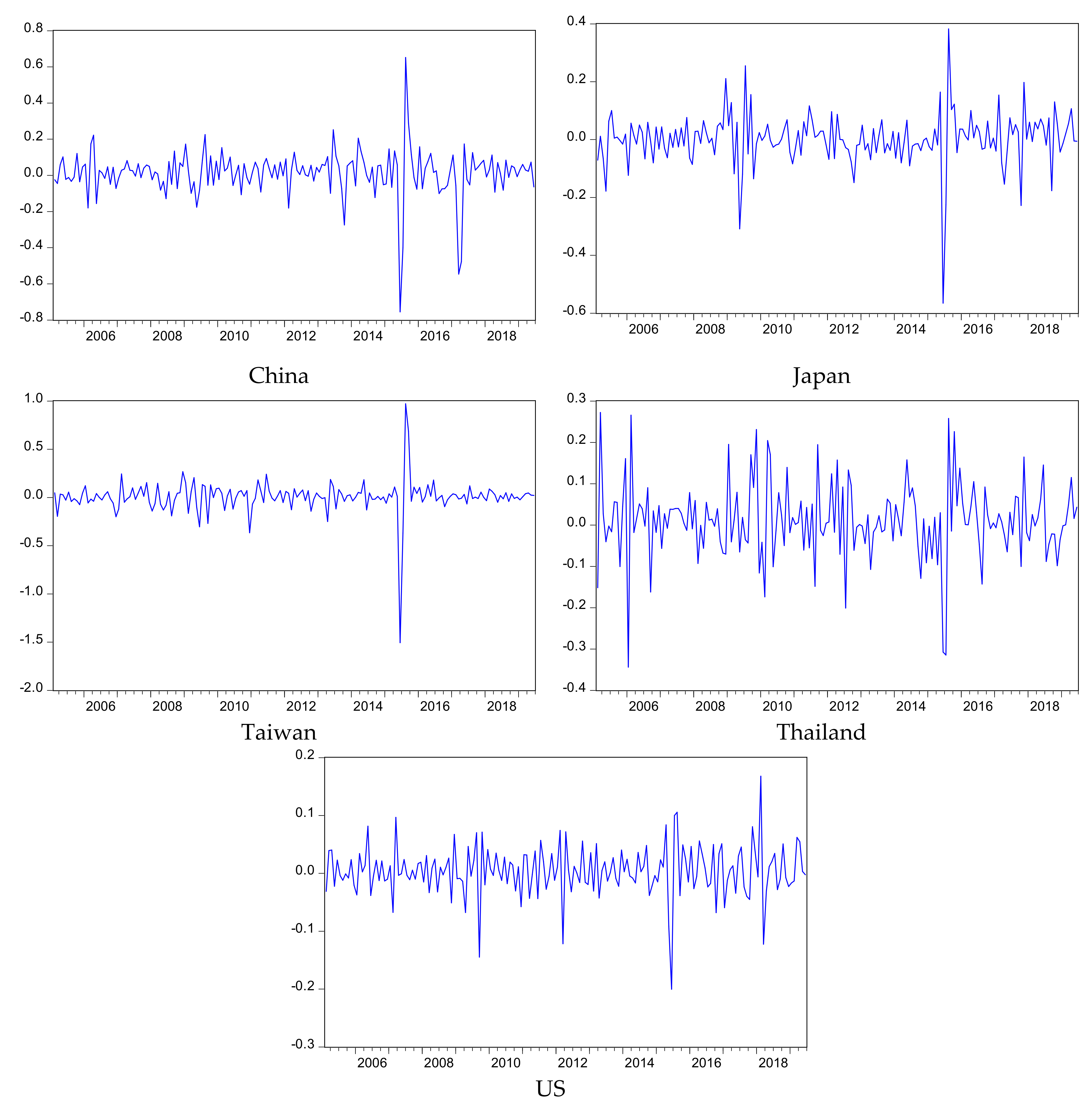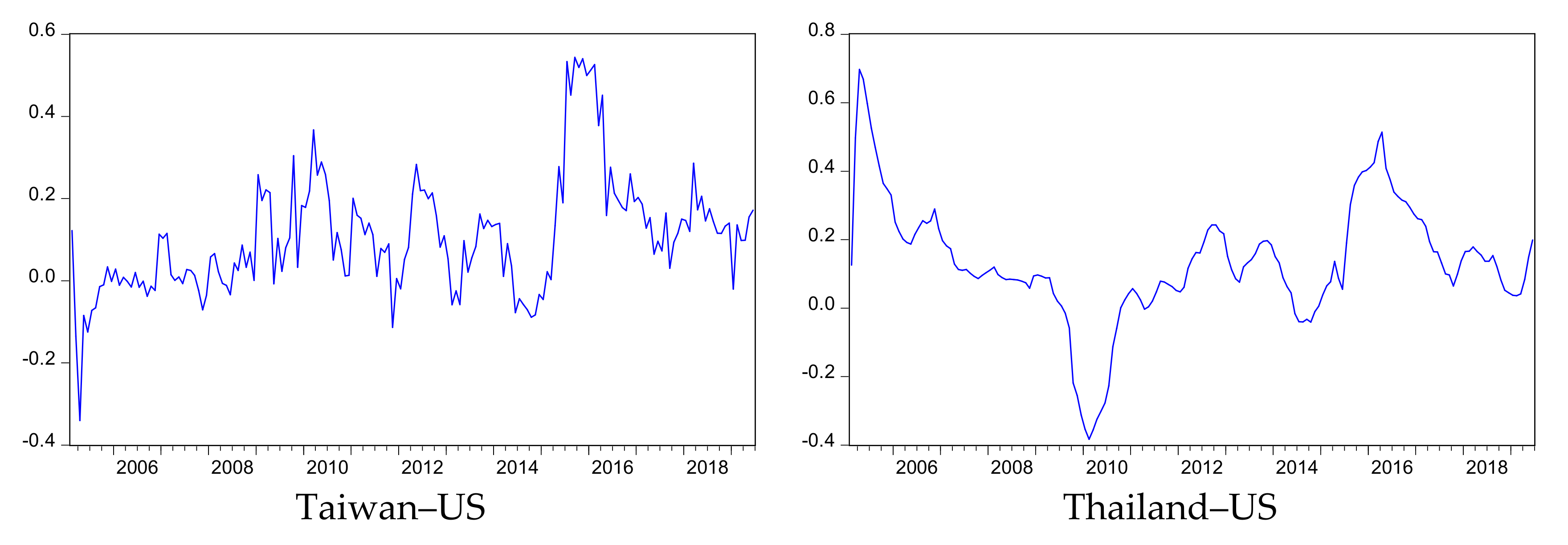Co-Movement between Tourist Arrivals of Inbound Tourism Markets in South Korea: Applying the Dynamic Copula Method Using Secondary Time Series Data
Abstract
1. Introduction
2. Literature Review
3. Methods and Data
3.1. Methods
3.2. Data
4. Results
4.1. Results for the Marginal Models
4.2. Results of the Static and Time-Varying Copulas
5. Conclusions
Author Contributions
Funding
Institutional Review Board Statement
Informed Consent Statement
Data Availability Statement
Conflicts of Interest
References
- Puarattanaarunkorn, O.; Sriboonchitta, S. Copula based GARCH dependence model of Chinese and Korean tourist arrivals to Thailand: Implications for risk management. In Modeling Dependence in Econometrics; Springer: New York, NY, USA, 2014; pp. 343–365. [Google Scholar]
- Lean, H.H.; Smyth, R. Asian financial crisis, avian flu and terrorist threats: Are shocks to Malaysian tourist arrivals permanent or transitory? Asia Pac. J. Tour. Res. 2009, 14, 301–321. [Google Scholar] [CrossRef]
- UNWTO. UNWTO Tourism Highlights 2015 Edition; World Tourism Organization: Madrid, Spain, 2015; Available online: https://www.e-unwto.org/doi/pdf/10.18111/9789284416899 (accessed on 25 January 2021).
- Zeng, B.; Carter, R.W.; de Lacy, T. Short-term perturbations and tourism effects: The case of SARS in China. Curr. Issues Tour. 2005, 8, 306–322. [Google Scholar] [CrossRef]
- Cooper, M. Japanese tourism and the SARS epidemic of 2003. J. Travel Tour. Mark. 2005, 19, 117–131. [Google Scholar] [CrossRef]
- Ministry of Culture, Sport and Tourism. 2018 Nyeon-Gijun Gwangwang-Donghyangegwanhanyeoncha-Bogoseo (2018 Annual Report on Tourism Trends); Ministry of Culture, Sports and Tourism: Seoul, Korea, 2019.
- Henderson, J.C. The Great East Japan earthquake and tourism: A preliminary case study. Tour. Recreat. Res. 2013, 38, 93–98. [Google Scholar] [CrossRef]
- Pérez-Rodríguez, J.V.; Ledesma-Rodríguez, F.; Santana-Gallego, M. Testing dependence between GDP and tourism’s growth rates. Tour. Manag. 2015, 48, 268–282. [Google Scholar] [CrossRef]
- Conell, J.; Page, S.J.; Meyer, D. Visitor attractions and events: Responding to seasonality. Tour. Manag. 2015, 46, 283–298. [Google Scholar] [CrossRef]
- Getz, D. Event tourism: Definition, evolution, and research. Tour. Manag. 2008, 29, 403–428. [Google Scholar] [CrossRef]
- Sainaghi, R.; Baggio, R. Destination events, stability, and turning points of development. J. Travel Res. 2019, 1–12. [Google Scholar] [CrossRef]
- Chan, F.; Lim, C.; McAleer, M. Modelling multivariate international tourism demand and volatility. Tour. Manag. 2005, 26, 459–471. [Google Scholar] [CrossRef]
- Hoti, S.; McAleer, M.; Shareef, R. Modelling international tourism and country risk spillovers for Cyprus and Malta. Tour. Manag. 2007, 28, 1472–1484. [Google Scholar] [CrossRef]
- Seo, J.H.; Park, S.Y.; Yu, L. The analysis of the relationships of Korean outbound tourism demand: Jeju Island and three international destinations. Tour. Manag. 2009, 30, 530–543. [Google Scholar] [CrossRef] [PubMed]
- Shareef, R.; McAleer, M. Modelling the uncertainty in monthly international tourist arrivals to the Maldives. Tour. Manag. 2007, 28, 23–45. [Google Scholar] [CrossRef]
- Wang, K.; Chen, Y.-H.; Huang, S.-W. The dynamic dependence between the Chinese market and other international stock markets: A time-varying copula approach. Int. Rev. Econ. Financ. 2011, 20, 654–664. [Google Scholar] [CrossRef]
- Silva Filho, O.C.; Ziegelmann, F.A.; Dueker, M.J. Assessing dependence between financial market indexes using conditional time-varying copulas: Applications to Value at Risk (VaR). Quant. Financ. 2014, 14, 2155–2170. [Google Scholar] [CrossRef]
- Tang, J.; Sriboonchitta, S.; Ramos, V.; Wong, W.-K. Modelling dependence between tourism demand and exchange rate using the copula-based GARCH model. Curr. Issues Tour. 2016, 19, 876–894. [Google Scholar] [CrossRef]
- Tang, J.; Ramos, V.; Cang, S.; Sriboonchitta, S. An empirical study of inbound tourism demand in China: A copula-GARCH approach. J. Travel Tour. Mark. 2017, 34, 1235–1246. [Google Scholar] [CrossRef]
- Zhu, L.; Lim, C.; Xie, W.; Wu, Y. Modelling tourist flow association for tourism demand forecasting. Curr. Issues Tour. 2018, 21, 902–916. [Google Scholar] [CrossRef]
- Tang, J.; Sriboondita, S.; Yuan, X.; Wu, B. Volatility co-movement of China outbound tourism: Dynamic copula based GARCH model. Int. J. Innov. Manag. Inf. Prod. 2013, 4, 51–64. [Google Scholar]
- Juan, Y.; Choi, Y.; An, S.; Lee, C.-K.; Lee, S.J. The constraints of Chinese tourists to visit Korea caused by THAAD using Q-methodology. Asia Pac. J. Tour. Res. 2017, 22, 1261–1273. [Google Scholar] [CrossRef]
- Korea Tourism Knowledge and Information System Statistics on Tourists. Available online: http://tour.go.kr (accessed on 23 December 2019).
- Song, H.; Qiu, R.T.R.; Park, J. A review of research on tourism demand forecasting: Launching the annals of tourism research curated collection on tourism demand forecasting. Ann. Tour. Res. 2019, 75, 338–362. [Google Scholar] [CrossRef]
- Moore, W.R. The impact of climate change on Caribbean tourism demand. Curr. Issues Tour. 2010, 13, 495–505. [Google Scholar] [CrossRef]
- Peng, B.; Song, H.; Crouch, G.I. A meta-analysis of international tourism demand forecasting and implications for practice. Tour. Manag. 2014, 45, 181–193. [Google Scholar] [CrossRef]
- Song, H.; Li, G. Tourism demand modelling and forecasting—A review of recent research. Tour. Manag. 2008, 29, 203–220. [Google Scholar] [CrossRef]
- Akadiri, S.S.; Eluwole, K.K.; Akadiri, A.C.; Avci, T. Does causality between geopolitical risk, tourism and economic growth matter? Evidence from Turkey. J. Hosp. Tour. Manag. 2020, 43, 273–277. [Google Scholar] [CrossRef]
- Athanasopoulos, G.; de Silva, A. Multivariate exponential smoothing for forecasting tourist arrivals. J. Travel Res. 2012, 51, 640–652. [Google Scholar] [CrossRef]
- Coshall, J.T. A selection strategy for modelling UK tourism flows by air to European destinations. Tour. Econ. 2005, 11, 141–158. [Google Scholar] [CrossRef]
- Russell, R.; Faulkner, B. Entrepreneurship, chaos and the tourism area lifecycle. Ann. Tour. Res. 2004, 31, 556–579. [Google Scholar] [CrossRef]
- Mckercher, B. A chaos approach to tourism. Tour. Manag. 1999, 20, 425–434. [Google Scholar] [CrossRef]
- Sainaghi, R.; Baggio, R. Complexity traits and dynamics of tourism destinations. Tour. Manag. 2017, 63, 368–382. [Google Scholar] [CrossRef]
- Aloui, R.; Aïssa, M.S.B.; Nguyen, D.K. Conditional dependence structure between oil prices and exchange rates: A copula-GARCH approach. J. Int. Money Financ. 2013, 32, 719–738. [Google Scholar] [CrossRef]
- Hanif, W.; Hernandez, J.A.; Sadorsky, P.; Yoon, S.-M. Are the interdependence characteristics of the US and Canadian energy equity sectors nonlinear and asymmetric? North Am. J. Econ. Financ. 2020, 51, 101065. [Google Scholar] [CrossRef]
- Hanif, W.; Arreola-Hernandez, J.; Hussain Shahzad, S.J.; Hoang, T.H.V.; Yoon, S.-M. Regional and copula estimation effects on EU and US energy equity portfolios. Appl. Econ. 2020, 52, 5311–5342. [Google Scholar] [CrossRef]
- Kang, S.H.; Uddin, G.S.; Ahmed, A.; Yoon, S.-M. Multi-scale causality and extreme tail inter-dependence among housing prices. Econ. Model. 2018, 70, 301–309. [Google Scholar] [CrossRef]
- Wu, C.-C.; Chung, H.; Chang, Y.-H. The economic value of co-movement between oil price and exchange rate using copula-based GARCH models. Energy Econ. 2012, 34, 270–282. [Google Scholar] [CrossRef]
- Sklar, M. Fonctions de repartition and dimensions et leurs marges. Publications de l’ Institut de statistique de l’ Universite de Paris 1959, 8, 229–231. [Google Scholar]
- Bollerslev, T. Generalized autoregressive conditional heteroskedasticity. J. Econom. 1986, 31, 307–327. [Google Scholar] [CrossRef]
- Clayton, D.G. A model for association in bivariate life tables and its application in epidemiological studies of familial tendency in chronic disease incidence. Biometrika 1978, 65, 141–151. [Google Scholar] [CrossRef]
- Gumbel, E.J. Bivariate exponential distributions. J. Am. Stat. Assoc. 1960, 55, 698–707. [Google Scholar] [CrossRef]
- Joe, H. Parametric families of multivariate distributions with given margins. J. Multivar. Anal. 1993, 46, 262–282. [Google Scholar] [CrossRef]
- Joe, H.; Hu, T. Multivariate distributions from mixtures of max-infinitely divisible distributions. J. Multivar. Anal. 1996, 57, 240–265. [Google Scholar] [CrossRef]
- Cech, C. Copula-Based Top-Down Approaches in Financial Risk Aggregation. 2006. Available online: https://ssrn.com/abstract=953888 (accessed on 12 March 2020).
- Baum, T. Seasonality in tourism: Understanding the challenges: Introduction. Tour. Econ. 1999, 5, 5–8. [Google Scholar] [CrossRef]
- Baum, T.; Hagen, L. Responses to seasonality: The experiences of peripheral destinations. Int. J. Tour. Res. 1999, 1, 299–312. [Google Scholar] [CrossRef]
- Sainaghi, R.; Mauri, A.G.; Inanov, S.; d’Angella, F. Mega events and seasonality: The case of the Milan World Expo 2015. Int. J. Contemp. Hosp. Manag. 2019, 31, 61–86. [Google Scholar] [CrossRef]



| China | Japan | Taiwan | Thailand | US | |
|---|---|---|---|---|---|
| Mean | 0.013 | 0.003 | 0.007 | 0.011 | 0.004 |
| Maximum | 0.652 | 0.383 | 0.971 | 0.272 | 0.168 |
| Minimum | −0.755 | −0.565 | −1.506 | −0.344 | −0.200 |
| Std. Dev. | 0.130 | 0.092 | 0.176 | 0.094 | 0.044 |
| Skewness | −1.376 | −1.158 | −2.551 | −0.262 | −0.541 |
| Kurtosis | 14.821 | 12.951 | 39.138 | 5.353 | 6.803 |
| Jarque–Bera | 1061.84 | 752.41 | 9601.38 | 41.89 | 112.68 |
| p-value | 0.000 | 0.000 | 0.000 | 0.000 | 0.000 |
| Observations | 173 | 173 | 173 | 173 | 173 |
| China | Japan | Taiwan | Thailand | US | |
|---|---|---|---|---|---|
| China | 1.000 | ||||
| Japan | 0.469 | 1.000 | |||
| Taiwan | 0.628 | 0.582 | 1.000 | ||
| Thailand | 0.203 | 0.413 | 0.245 | 1.000 | |
| US | 0.170 | 0.215 | 0.328 | 0.150 | 1.000 |
| China | Japan | Taiwan | Thailand | US | |
|---|---|---|---|---|---|
| Mean Equation | |||||
| 0.016 *** (0.004) | 0.002 (0.689) | 0.005 (0.404) | 0.008 (0.168) | 0.004 *** (0.000) | |
| −0.140 (0.158) | −0.160 * (0.053) | −0.156 (0.133) | −0.505 ** (0.000) | ||
| −0.075 (0.363) | −0.187 * (0.010) | 0.073 (0.546) | −0.284 ** (0.000) | ||
| Variance Equation | |||||
| 0.004 (0.071) | 0.003 ** (0.000) | 0.004 (0.141) | 0.003 ** (0.001) | 0.000 (0.745) | |
| 0.450 * (0.057) | 0.474 ** (0.012) | 0.500 (0.499) | 0.512 ** (0.007) | 0.034 (0.236) | |
| 0.407 *** (0.005) | 0.240 *** (0.004) | 0.499 ** (0.0054) | 0.184 * (0.056) | 0.9649 *** (0.000) | |
| Skewness | 0.790 *** (0.000) | 0.906 *** (0.000) | 0.855 ** (0.000) | 0.973 *** (0.000) | 0.986 *** (0.000) |
| Shape | 3.2362 *** (0.0000) | 3.8202 *** (0.0000) | 2.5921 *** (0.0000) | 5.2730 *** (0.0023) | 3.0701 *** (0.0000) |
| Pairs | Best Copula | Kendall’s Tau | Lower | Upper |
|---|---|---|---|---|
| China–Japan | Survival-Joe | 0.091 | 0.197 | - |
| China–Taiwan | Gaussian | 0.223 | - | - |
| China–Thailand | Survival-Joe | 0.049 | 0.111 | - |
| China–US | Survival-Gumbel | 0.103 | 0.138 | - |
| Japan–Taiwan | Student’s t | 0.124 | 0.178 | 0.178 |
| Japan–Thailand | Survival-Joe | 0.124 | 0.257 | - |
| Japan–US | Student’s t | 0.124 | 0.178 | 0.178 |
| Taiwan–Thailand | Student’s t | 0.028 | 0.067 | 0.067 |
| Taiwan–US | Student’s t | 0.069 | 0.150 | 0.150 |
| Thailand–US | Student’s t | 0.080 | 0.125 | 0.125 |
Publisher’s Note: MDPI stays neutral with regard to jurisdictional claims in published maps and institutional affiliations. |
© 2021 by the authors. Licensee MDPI, Basel, Switzerland. This article is an open access article distributed under the terms and conditions of the Creative Commons Attribution (CC BY) license (http://creativecommons.org/licenses/by/4.0/).
Share and Cite
Choi, K.-H.; Kim, I. Co-Movement between Tourist Arrivals of Inbound Tourism Markets in South Korea: Applying the Dynamic Copula Method Using Secondary Time Series Data. Sustainability 2021, 13, 1283. https://doi.org/10.3390/su13031283
Choi K-H, Kim I. Co-Movement between Tourist Arrivals of Inbound Tourism Markets in South Korea: Applying the Dynamic Copula Method Using Secondary Time Series Data. Sustainability. 2021; 13(3):1283. https://doi.org/10.3390/su13031283
Chicago/Turabian StyleChoi, Ki-Hong, and Insin Kim. 2021. "Co-Movement between Tourist Arrivals of Inbound Tourism Markets in South Korea: Applying the Dynamic Copula Method Using Secondary Time Series Data" Sustainability 13, no. 3: 1283. https://doi.org/10.3390/su13031283
APA StyleChoi, K.-H., & Kim, I. (2021). Co-Movement between Tourist Arrivals of Inbound Tourism Markets in South Korea: Applying the Dynamic Copula Method Using Secondary Time Series Data. Sustainability, 13(3), 1283. https://doi.org/10.3390/su13031283






